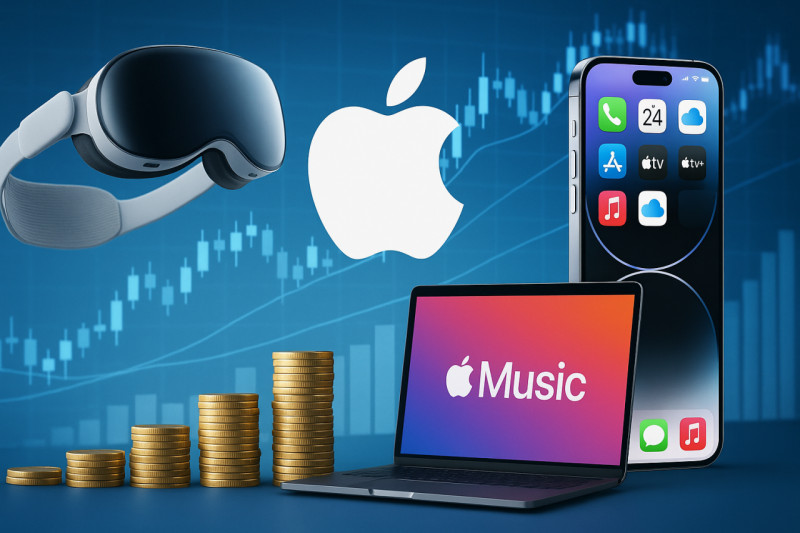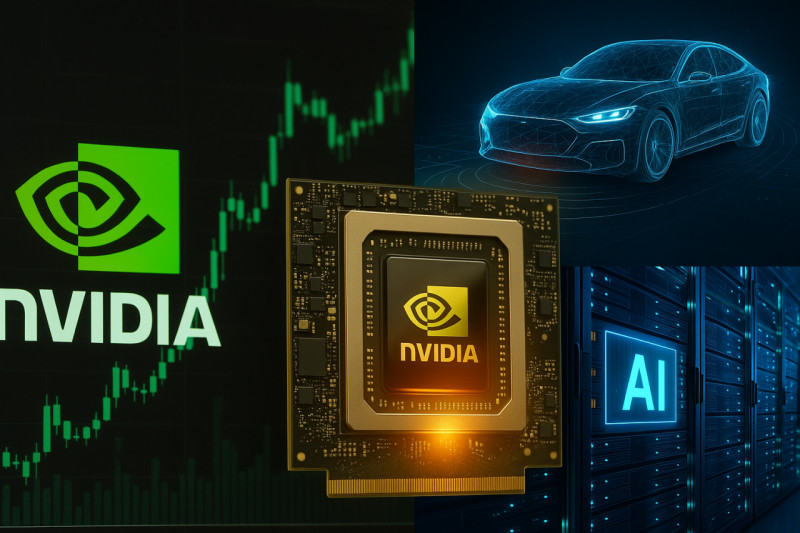The IT industry has long ceased to be a niche segment. Today, it is one of the driving forces of the global economy. Tech sector stocks attract investors worldwide with their growth potential, innovation, and high liquidity. However, volatility remains an inherent part of the game. In this article, we will take a detailed look at which IT companies deserve attention in 2025, which tech stocks appear promising, and highlight the best stocks to buy, including volatile options that can deliver high returns.
Why invest in IT companies in 2025?
The world continues its rapid shift into the digital realm. Artificial intelligence, cloud computing, cybersecurity, and quantum technologies are forming the foundation of the future economy. IT companies hold key positions in these areas and, as a result, have become a focal point for investors.
Key advantages of the tech sector:
- Higher growth rates than most traditional industries
- Global scale—most companies operate not only in the US but worldwide
- Flexibility and innovation, allowing quick adaptation to market changes

Analysis of top IT companies
Apple Inc. (AAPL)
Apple Inc. continues to maintain its leadership position in the technology sector. As of 2025, the company is actively investing in new technologies, including wearable electronics, augmented reality (AR) with its Vision Pro product, and the development of its own chips. A key growth factor is business diversification: revenue from services such as Apple Music, iCloud, and Apple TV+ has exceeded $100 billion over the past 12 months.
Why invest?
- Strong brand and loyal customer base
Apple does not just sell devices—it creates a unique ecosystem that fosters brand loyalty. Apple products are not just gadgets but part of the daily lives of millions of users worldwide. - Growing services segment
Revenue from services continues to rise, significantly reducing the company's reliance on physical product sales. Services like Apple Music, Apple TV+, and iCloud have become crucial sources of stable income. - Regular buybacks and dividends
Apple actively repurchases its shares and pays dividends, signaling financial stability and commitment to shareholders. Buybacks help increase stock value and earnings per share.
Prospects and risks:
Despite its successes, Apple faces competition in the smartphone market, particularly from Chinese manufacturers. Risks also include dependence on global supply chains and increasing government regulation, which could impact its business.

Microsoft Corporation (MSFT)
Microsoft maintains its position as a technology leader, particularly in cloud solutions. In 2025, the company significantly strengthened its standing in the cloud computing market. Microsoft's Azure platform ranks second in market share, trailing only Amazon Web Services (AWS). Through continuous innovation and business-focused adaptability, Azure demonstrates steady growth by providing enterprises with efficient data storage and processing solutions. The ongoing digital transformation across industries is driving increased demand for Microsoft's cloud services.
Beyond cloud computing, Microsoft is actively integrating artificial intelligence (AI) into its products. A major development is the implementation of Copilot, an AI assistant now embedded in Office 365 applications. This significant enhancement boosts user productivity and creates new business opportunities. Copilot streamlines data processing, improves communication, and automates routine tasks, making Microsoft's products even more attractive to global enterprises.
Investment highlights:
- Stable cash flows
Microsoft delivers consistent financial performance, generating strong cash flow from cloud services, enterprise solutions, and products such as Office 365 and Windows. This stability enables continuous profit generation and substantial innovation investment, supporting long-term growth. - AI integration in enterprise services
Incorporating AI technologies into Microsoft's enterprise services increases their business value. Features like Copilot help companies automate processes, improving efficiency while reducing costs.
Cloud solution expansion
Azure's development and the business migration to cloud technologies ensure Microsoft's long-term growth. As cloud platforms become fundamental to modern enterprises, Microsoft continuously enhances its cloud services, expanding capabilities for clients worldwide.

NVIDIA Corporation (NVDA)
NVIDIA continues to firmly maintain its leading position in graphics processing units (GPUs) and artificial intelligence (AI). In recent years, the company has become one of the primary beneficiaries of the technological revolution, driven by the rapid development of artificial intelligence and high-performance chips. In 2024, its revenue grew by 80%, a result of massive increased demand for its products, particularly in AI and the computing power required for big data processing.
NVIDIA plays a pivotal role in manufacturing chips for AI and machine learning, making it a key player in rapidly growing markets such as cloud computing, deep learning, and data processing. The company's powerful GPUs are widely used in data centers, where vast computational resources are needed to process and analyze large volumes of information.
In addition, NVIDIA is actively involved in developing supercomputers and autonomous systems, including self-driving cars and robotics. These technologies are becoming increasingly in demand, creating new growth opportunities for the company. Its advancements in autonomous vehicle technology and hybrid computing make it attractive to long-term investors looking to support its growth in the era of digital transformation.
Investor advantages:
- Leadership in AI chips
NVIDIA remains the primary supplier of chips for AI, machine learning, and data processing technologies. Its products are extensively used in data centers, ensuring sustained high demand in the future. - Growth of data centers
With increasing demand for big data processing and cloud computing, data centers have become a critical infrastructure component, and NVIDIA’s chips play a key role in these technologies. Demand for computing power is expected to keep rising, driving further revenue growth for the company.
Involvement in supercomputers & autonomous systems development
NVIDIA is actively investing in supercomputer development, essential for complex computations in scientific research, healthcare, and advanced technologies. The company is also making strides in autonomous vehicle systems, opening new avenues for future expansion.

Amazon (AMZN)
Amazon remains the undisputed leader in e-commerce, but its primary growth driver in recent years has been its cloud computing division, Amazon Web Services (AWS). In 2025, AWS continues to demonstrate steady growth thanks to the widespread adoption of cloud solutions by businesses worldwide. Cloud technologies have become Amazon's key profit generator, delivering high margins and consistent cash flows.
In addition to its cloud business, Amazon is actively investing in logistics automation. The company is implementing robots, drones, and AI systems in its delivery processes, significantly reducing costs and improving efficiency. This reduces reliance on external suppliers and makes Amazon's infrastructure more resilient to disruptions.
Amazon is also expanding aggressively in emerging markets, including India, Latin America, and Southeast Asia. The growing number of Internet users in these regions presents significant opportunities for business scaling and revenue growth.
Why Amazon remains attractive:
- Sustained growth of AWS
- Active investments in automation and logistics
- Expansion into high-potential markets

Alphabet Inc. (GOOGL)
Alphabet, Google's parent company, is actively investing in cutting-edge technologies while expanding its presence across key digital economy sectors. In 2025, particular focus is being placed on artificial intelligence development, especially its Gemini model being integrated across Google products including search and office applications. This creates new monetization streams and strengthens competitive advantages.
Google Cloud has become an increasingly significant revenue driver, showing consistent growth through enterprise clients. Its cloud services are evolving toward security, analytics and AI-powered business solutions, boosting their market demand.
Moreover, Alphabet is advancing quantum computing and autonomous technologies through subsidiaries like Waymo.
Investment arguments:
- Market leadership in AI and advanced R&D
- Effective AI-powered search monetization
- Rapid cloud services segment expansion
Volatile IT sector: key players

Palantir Technologies (PLTR)
Palantir develops powerful analytical platforms that help government and commercial entities process big data and make data-driven decisions. The company's products are actively used in defense, intelligence, healthcare, finance, and industrial sectors. Key clients include the U.S. Department of Defense and EU agencies. In 2024–2025, Palantir secured and renewed several major government contracts, ensuring stable cash flows.
Investment arguments:
- High profit margins: Palantir's subscription-based business model generates stable revenue with low variable costs. Operating margins exceed 30%, making the company attractive for long-term investors.
- Growth in commercial segment: Beyond government contracts, Palantir is expanding its presence in private sectors, including finance, healthcare, and manufacturing (Uber, Boeing, Morgan Stanley are among the company’s clients).
- AI-powered analytics: Active integration of artificial intelligence enhances Palantir's platform competitiveness, improving the speed and accuracy of analytical insights.
Risks:
- Dependence on government contracts and potential budget cuts
- Competition from major players (Snowflake, Google Cloud, Microsoft)
- Reputational risks and data privacy concerns

Snowflake Inc. (SNOW)
Snowflake is one of the leaders in cloud technology, providing a platform for data storage and analysis. The company offers a flexible SaaS solution that enables organizations to consolidate, process, and scale data in the cloud. Its key advantage lies in its architecture, which delivers high performance at optimal costs.
In 2024, Snowflake increased its revenue by over 30%, a result of growing demand for cloud analytics solutions. The company is actively expanding its corporate client base, serving industry giants such as Netflix, Adobe, and Capital One. This demonstrates product reliability and builds a stable subscriber foundation.
Snowflake is developing partnerships with major cloud platforms (AWS, Azure, Google Cloud), strengthening its ecosystem. It is also integrating AI services to expand its platform's applications.
Risks:
- Intense competition from Amazon, Google, and Microsoft
- Dependence on large enterprise clients
- Potential demand slowdown during economic downturns
Nevertheless, Snowflake remains an attractive stock for investors focused on growth in cloud technology.

Unity Software Inc. (U)
Unity is one of the world's leading developers of game engines and interactive 3D technologies. The company provides a platform used to create thousands of games, applications, and simulations, from mobile games to architectural visualizations and training systems for medicine and aviation. Unity occupies a unique position at the intersection of gaming technology, artificial intelligence, and extended reality.
Although Unity's stock faced pressure in 2022-2023, 2024 and early 2025 have shown signs of recovery. This turnaround can be attributed to the company's strengthened position in the AR/VR market and renewed interest in metaverse projects. Particularly significant are contracts with industry giants such as Meta (Quest ecosystem and Horizon) and Microsoft, which uses Unity solutions for corporate training systems and HoloLens.
Investment appeal factors:
- Metaverse and immersive technologies: Unity is a primary tool for creating digital worlds. As major players again bet on virtual spaces, Unity could become a key contractor for technology and entertainment companies.
- Expansion beyond gaming: The platform is actively used in architecture, film (animation and VFX), automotive design, and even defense, making the business more resilient to gaming sector fluctuations.
- AI animation and generative technologies: Unity is integrating machine learning tools to automate animation, object behavior, and content generation, reducing costs and accelerating development while opening new opportunities for studios and developers.
Risks and challenges:
- Strong competition from Unreal Engine (Epic Games), especially in AAA gaming and film segments
- Rising costs: Developing new directions requires significant investments, impacting profitability
- Monetization: The shift to new subscription models drew criticism from indie developers and temporarily reduced audience loyalty
Nevertheless, Unity's strategic direction focuses on long-term growth. If AR/VR technologies achieve mass adoption and metaverses enter a new development phase, Unity will be among the primary beneficiaries of this technological transformation.
Coinbase Global Inc. (COIN)
Coinbase stands as one of the world's largest cryptocurrency exchanges, offering a simple and intuitive interface that has attracted both retail investors and institutional clients. The company serves as a gateway to the crypto world for millions of users. With renewed interest in digital assets gaining momentum, Coinbase remains at the center of key industry trends.
Since early 2025, COIN shares have shown significant volatility while maintaining an upward trajectory, driven by several factors. A primary growth catalyst has been increased Bitcoin demand through new financial instruments, including Bitcoin ETFs. The introduction of these products in US markets has boosted trading activity, directly benefiting Coinbase through transaction fees.
The company continues expanding its service offerings: institutional custody solutions, staking services, derivatives trading, and its proprietary blockchain infrastructure (Base) are creating a more diversified business model resilient to spot market fluctuations.
Risks and opportunities:
- Crypto market volatility: Even short-term Bitcoin and Ethereum price declines may reduce trading activity and Coinbase revenue
- Regulatory scrutiny: Ongoing SEC oversight and legal proceedings could impact the business model
Nevertheless, COIN demonstrates strong profitability (with operating margins exceeding 35% in some quarters) and maintains substantial liquidity to weather market instability.
As such, Coinbase remains an attractive, albeit volatile, investment in the fintech and crypto economy. The stock suits investors willing to assume risk for potentially high returns, particularly when employing momentum or growth strategies.

Choosing top-performing stocks: key selection criteria
Investing in IT sector stocks requires a comprehensive approach. The high-tech sector is extremely dynamic: some companies grow rapidly through innovation, while others lose market share due to competition and outdated technologies. Therefore, selecting the best stocks to buy is not guesswork but the result of systematic analysis. Let’s examine the key parameters to consider when building an investment portfolio.
Financial reports: stability, margins, and profitability
Financial stability is one of the most critical factors when evaluating any company. When choosing stocks, it is worth paying attention to steady revenue growth, positive operating and net profit, as well as margin levels. For example, Microsoft demonstrates consistent profit growth, high margins (its operating margin is above 40%), and stable free cash flow, making it a reliable investment even during market volatility.
Market position: leadership, innovation, brand recognition
IT companies with strong competitive advantages are generally less prone to fluctuations. You need to assess:
- market share in key segments
- growth rates compared to competitors
- patents and technological solutions
- brand strength and customer loyalty
For example, Apple remains one of the most influential players in consumer electronics due to its product ecosystem and exceptionally high customer retention.
Technological potential: participation in trending niches
Pay attention to the company's focus areas:
- AI development and implementation
- cloud solutions and SaaS
- cybersecurity and Big Data
- subscription models (recurring revenue)
Snowflake and Palantir are actively developing cloud platforms for data analytics and machine learning, positioning them as potential leaders in their respective niches.
Valuation: reasonable price for prospects
Even the most promising companies can be overvalued. To assess fair value, compare these multiples:
- P/E (Price/Earnings) – for mature companies with stable profits
- EV/EBITDA – for more accurate debt-adjusted valuation
- P/S (Price/Sales) – particularly useful for high-growth, yet unprofitable companies
It is crucial to compare a company not just against the sector but also against direct competitors. For example, Snowflake has the highest P/E (120x), justified by its aggressive growth, but this also increases risks during market corrections.
These metrics help investors quickly assess fundamental valuations. However, please remember that final decisions should account for industry trends, financial goals, and personal risk tolerance.
IT stock investment strategies
Depending on your risk profile, investment goals, and time horizon, several proven strategies can be effectively applied when investing in IT sector stocks. Below we examine the most popular approaches and provide recommendations for their application in the context of 2025 market conditions.
1. Buy & Hold strategy
This classic long-term strategy involves purchasing high-quality stocks and holding them in a portfolio for many years. It is suitable for risk-averse investors focused on steady capital appreciation. Companies such as Apple, Microsoft, and Google (Alphabet) boast high market capitalization, stable financial performance, and regular dividend payments. While these stocks may not deliver explosive growth, they offer reliability and lower susceptibility to sharp fluctuations.
Advantages:
- Low transaction costs
- Protection against short-term volatility
- Compounding returns through dividend reinvestment
Disadvantages:
- Limited flexibility
- Potential missed opportunities during market cycle shifts
2. Growth investing
Investors focused on breakthrough technologies and fast-growing companies often choose growth investing. Companies like Snowflake, NVIDIA, and Palantir may not always be profitable by traditional metrics but demonstrate rapid revenue growth and market share expansion.
When to use:
- If you can tolerate high volatility
- If you have a long investment horizon (over 5 years)
- If you are targeting maximum returns
Key metrics to watch: revenue growth rates, burn rate, technological leadership, and solution scalability.
3. Momentum trading
This strategy is suited for active investors and traders looking to capitalize on short-term market movements. Stocks of companies like Coinbase and Unity often react to news, earnings reports, or external events (e.g., Bitcoin rallies or product launches).
How to use:
- Analyze charts, patterns, and volume levels
- Set clear stop-loss orders
- Monitor real-time news feeds
Risks: High volatility may lead to rapid capital loss without strict trading discipline.
4. Sector diversification
The IT sector offers diverse opportunities, from blue chips to startups, from cloud solutions to metaverse projects. By combining companies with different risk profiles and business models, investors can reduce overall portfolio volatility while improving stable returns potential.
Sample portfolio allocation:
40% - stable companies (Apple, Microsoft)
30% - growth companies (NVIDIA, Snowflake)
20% - volatile stocks (Palantir, Coinbase)
10% - innovative startups (Unity, CrowdStrike)
Conclusion
Your investment strategy should align with your risk tolerance, experience and financial goals. Sometimes a blended approach delivers better results than focusing on a single strategy. The key lies in maintaining discipline, conducting regular portfolio reviews, and adapting to market changes.
IT companies continue attracting investors by offering both stability and short-term profit potential. When investing in tech stocks, particularly volatile ones, combining fundamental analysis with market trend awareness proves crucial.
The best stocks to buy are those matching your strategy and objectives. Carefully analyze financial reports, monitor technological breakthroughs, and never overlook risk management.









 Back to articles
Back to articles



